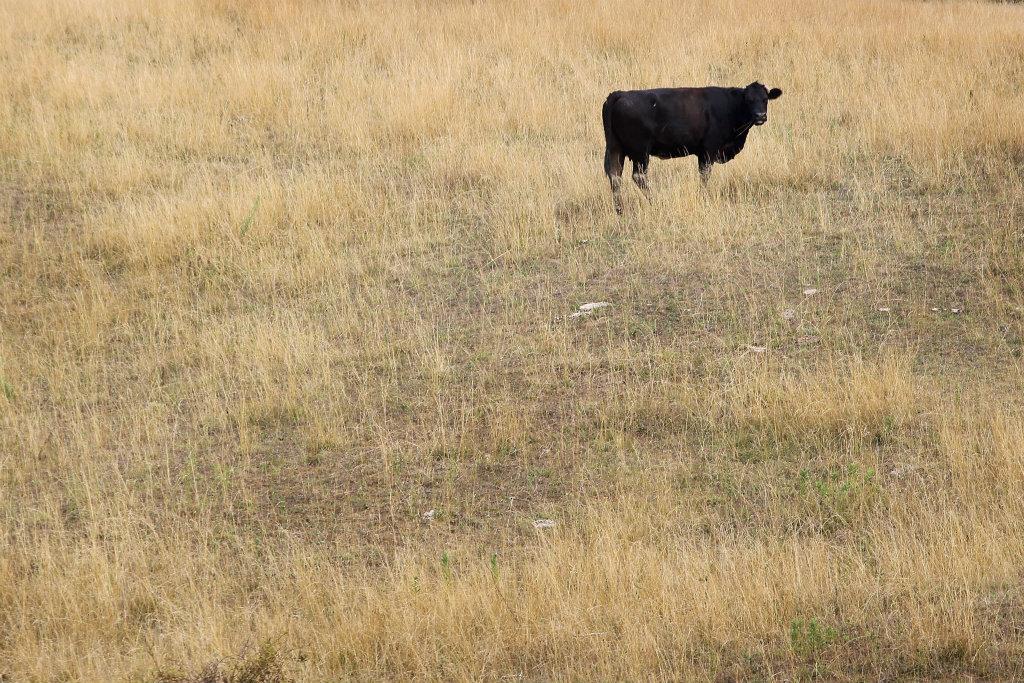Cowpocalypse: Prepare for the largest-ever drop in livestock herds
A cow feeds in a drought-damaged pasture as temperatures climb near 100 degrees in Indiana.
Morgan Stanley analyst Hussein Allidina is out with his latest agricultural commodities update.
The news: We are in for a big burn on prices, as record heat and drought roasts corn and soybean crops into oblivion.
"We are raising our 2012/2013 corn and soy forecasts to account for tighter-than-expected balances. Our new price deck implies 3 percent and 4 percent upside to the corn and bean curves, respectively. While we expect that corn and soybean prices to average $7.85/bu and $16.00/bu, respectively,in the coming year, we expect that the inelastic nature of demand for these products, and the prospect of record tight inventories could send prices significantly higher for short periods of time in 2H12. Indeed, we anticipate periods of time in the coming months where corn trades in double-digits."
The USDA's current forecasts, he says, are way too optimistic.
"With US weather forecast to remain hot and dry through at least end-July and likely into August, the direction of yield estimates and production is likely lower still. Our yield forecasts, which assume July weather averages roughly as it has to date, with August’s weather deviation from normal half as strong as July, pegs corn and bean yields at 135.0 bu/acre and 40.0 bu/acre, respectively — versus the USDA at 146.0 bu/acre and 40.5 bu/acre.
…
"The USDA’s above-normal assumption of harvested/planted (H/P) area will likely prove too optimistic, with reports already emerging that fields are being abandoned; we forecast the H/P ratio flat YoY at 91.4 percent. History portends further downside to this estimate, as years with severe droughts also see greater abandonment (see Exhibit 8). Each 100bp decrease in the H/P ratio will temper production by 130 mln bu (assuming yields average 135.0 bu/acre).
And we haven't begun talking about what the effect will be for livestock. The feed reduction implied by the crop yield drop will translate into the largest-ever decline in livestock herds.
"Even assuming an incremental 46 million bu (23 percent) of US wheat feeding YoY in 12/13, our feed demand model suggests that this degree of corn feed rationing would require a nearly 10.17 mln unit decline in the USDA’s grain consuming animal unit (GCAU) index from its current estimate of 92.93 mln.
"While these cuts will have to be spread across the entire livestock industry, this decline in GCAU, if taken in one sector alone would translate into a 5.09 bln head (60 percent) YoY reduction in chicken production, a 6.6 mln head (48 percent) reduction in cattle on feed YoY or a 44 mln head (40 percent) reduction in the US pig crop.
"It would also represent the largest single-year reduction in the livestock herd (from a grain-demand perspective) in history. To achieve the magnitude of rationing needed, in the limited amount of time available, corn and and bean prices will need to move higher yet, in our view."
More from our partners at Business Insider:
Business Insider: A Top Economist Explains Why China Won't Unleash Stimulus To Accelerate Growth
Business Insider: 11 Wild Facts About The Corn Industry In America
Business Insider: A French Company Is Launching A New 'Aphrodisiac Drink' Named DSK
Business Insider: Swedish and Bulgarian Officials Deny That This Swedish Extremist Was The Bus Suicide Bomber
Business Insider: US Trails At Least 15 OECD Countries In Median Wealth
The story you just read is accessible and free to all because thousands of listeners and readers contribute to our nonprofit newsroom. We go deep to bring you the human-centered international reporting that you know you can trust. To do this work and to do it well, we rely on the support of our listeners. If you appreciated our coverage this year, if there was a story that made you pause or a song that moved you, would you consider making a gift to sustain our work through 2024 and beyond?
